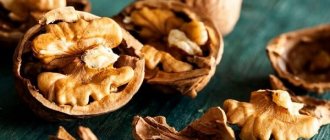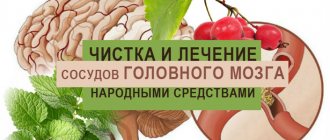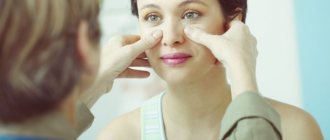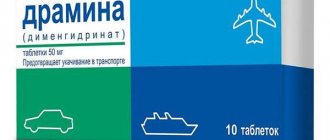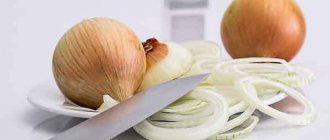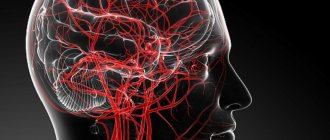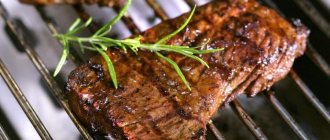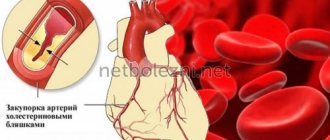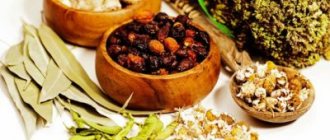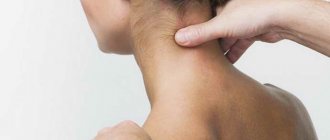The complex of health care measures must necessarily include procedures for cleaning blood vessels. An unhealthy lifestyle leads to clogging of the body’s arteries and causes the development of atherosclerosis. This disease entails the development of more serious pathological changes in the heart and leads to heart attacks and strokes.
Not only medications, but also herbs can be used to clean blood vessels. It is not enough to know the name of such herbs; it is important to use them correctly, following recipes and maintaining proportions
Causes of clogged blood vessels
The opinion that clogged blood vessels are typical for older people or those with chronic diseases is fundamentally wrong. Many factors lead to such a pathological change in the condition of blood vessels. Some of them can be easily discarded, since their presence depends on the person himself. And others cannot be avoided.
The reasons why blood vessels become fragile and the walls thicken:
- negative impact of the environment, poor ecology;
- unbalanced diet with a predominance of fatty, fried and spicy foods;
- presence of bad habits: smoking, alcohol;
- the effect of chronic diseases on blood vessels.
The human body is a complex system that, like technology, has a program for self-cleaning blood vessels. The program starts at the moment when the accumulation of substances harmful to the body reaches a certain level and the blood vessels become clogged with decay products.
But when such accumulation occurs too quickly, exceeding the permissible level tens of times, independent cleaning can no longer cope. The abundance of waste and toxins that causes vascular atherosclerosis causes the body to signal that it needs help.
5 more effective remedies
Besides herbs, there are other effective herbal remedies. The most common of them is garlic in combination with other products. Such folk remedies help regenerate the damaged inner surface and accelerate the formation of new muscle fibers.
The most effective and proven options:
- garlic, a competitor to any other “green doctor”, infused in vodka, has a higher concentration of beneficial components;
- crushed garlic mixed with crude vegetable oil and lemon juice is an excellent composition for increasing the elasticity of the canals and cleaning the walls;
- equal parts of garlic, lemon with peel and ground horseradish, infused with water - another unique medicinal product;
- onions of any kind act as a liquidator of cholesterol plaques, while being able to gently dilate blood vessels.
- wild garlic, a juicy spring herb, can be consumed fresh, but it is better to prepare an alcohol tincture with a longer shelf life;
Symptoms of clogged blood vessels
Atherosclerotic changes in blood vessels are among the most rapidly progressing and dangerous. The symptoms that appear should not be ignored; you should immediately visit a doctor.
It is better to start treating any disease at the initial stage; only in this case will it be possible to avoid global health problems, use herbs in therapy rather than drugs, and save money.
Symptoms of “dirty” vessels:
- memory impairment;
- constant fatigue, which manifests itself already in the first half of the day, subject to normal night rest;
- decreased performance;
- frequent dizziness accompanied by disorientation;
- head fights;
- frequent nausea;
- hair loss;
- increased blood pressure;
- decreased function of vision, hearing, and smell;
- the appearance of seizures;
- frequent viral diseases;
- weight fluctuations for no apparent reason.
Taking care of the health of blood vessels is everyone’s task, but for people who have bad habits, examination of the condition of blood vessels should be carried out at certain intervals. It is better to undergo an examination once a year, not limiting yourself to studying only one organ. Particular attention is paid to the vessels of the brain.
Why do you need to clean vessels?
Blood vessels lose strength over time and become brittle and vulnerable. The causes of such negative phenomena are age-related changes, previous injuries, poor diet, alcohol and smoking. Under the influence of these factors, the vessels stretch, thin out and become vulnerable. If vascular diseases are accompanied by high blood pressure, there is a danger of rupture of blood arteries.
Poor vascular condition can be determined by the following symptoms:
- periodic pressure surges;
- dizziness and weakness;
- fainting and rapid heartbeat;
- increased body temperature;
- darkening of the eyes;
- cold extremities.
Particularly dangerous is the rupture of the blood channels of the brain, which in most cases leads to a stroke and death. With timely diagnosis, the risks of hypertension and heart attack can be significantly reduced.
How and why to carry out the cleansing procedure
If “growths” are detected on the walls of blood vessels, their cleansing is indicated. The growths are made up of “low” cholesterol, which accumulates in the blood and is broken down as needed. Excess undigested cholesterol leads to the formation of plaques inside the vessels, which can thicken to enormous sizes.
Such plaques interfere with normal blood flow and supply to all organs. Lead to the formation of blood clots, which cause heart attacks, strokes, and deaths
There are many methods for cleaning blood vessels. Serious contamination will require the use of serious medications and a set of measures.
The initial stage, which involves a small level of contamination of the vessel, allows the use of traditional medicine and homeopathy in treatment.
Before cleaning blood vessels, the body must be prepared and the entire lifestyle must be reviewed. It is necessary to exclude those factors that a person can influence independently:
- giving up bad habits, fatty foods, emotional experiences, and taking certain medications. Without an integrated approach, not a single cleaning of blood vessels will help.
Rules for the cleaning procedure:
- regularity and frequency. You cannot take herbs that cleanse blood vessels every now and then; the approach to treatment must be serious;
- the finished herbal preparation should be stored in the refrigerator and not used after the expiration date;
- You should buy herbs from a pharmacy chain and strictly monitor the expiration date. After opening the package, store according to the rules indicated on it;
- Before starting vascular treatment, measures are taken to cleanse the liver.
During the treatment of blood vessels, it is necessary to increase the amount of clean water consumed, follow a diet and perform a set of simple physical exercises
Diet of cardiac patients
It is necessary to limit table salt and include foods rich in potassium salts: baked potatoes, green onions, parsley, apricots, dried apricots, figs, prunes, apricots, bananas. Coffee beans contain a lot of potassium, but instant coffee does not! And also in black tea leaves. Green tea contains several powerful antioxidants that lower cholesterol and help normalize blood pressure. 3 teaspoons of green tea are poured into 0.5 liters of boiling water, steeped for 10 minutes and filtered. This amount is enough for a day.
It is highly recommended to distribute the diet into 5-6 meals. The last meal should be no later than 18-19 hours.
Eating any vegetables and fruits is beneficial. It is advisable to consume from 5 to 7 different types daily. Eggplants occupy a special place; they help eliminate cholesterol and also reduce its content in the blood and in the walls of blood vessels.
Nuts have a similar effect:
- peanut,
- walnuts,
- cashew nuts,
- hazel,
- almond,
- hazelnut.
Research shows that eating 150g of shelled nuts per week reduces the risk of coronary artery disease and heart attack by 33% in some patients. However, you should not get carried away with nuts, since these are very high-calorie foods that contribute to weight gain.
Cabbage is very useful:
- broccoli,
- Brussels sprouts
- white cabbage,
- colored.
They contain antioxidants and other valuable biologically active substances that are beneficial for blood vessels and the heart.
It is recommended to eat 2-4 sweet and sour apples daily. Black currants, shadberry and garlic are useful.
Traditional methods of treating vascular atherosclerosis are mainly associated with the use of healthy products that can be found in any garden and summer cottage.
Contraindications to cleansing blood vessels with herbs
Before starting vascular treatment, you should consult a doctor about contraindications, the presence of diseases and the possibility of discontinuing medications taken that affect the liver and can cause blood clots.
Although herbs are a natural component, their unreasonable, uncontrolled use can cause more serious harm to health than the disease that is treated with their help.
Contraindications for herbal therapy:
- the presence of chronic kidney and liver diseases in the acute stage;
- heart pathologies;
- pathological changes in blood vessels;
- ulcerative changes in the gastrointestinal tract;
- cerebral circulatory disorders;
- pregnancy, lactation;
- children's age - strict dosage;
- allergy to one of the medicinal herbs;
- varicose veins;
- thrombophlebitis.
Hypertension
Not all of these diseases require a complete cessation of the use of herbs in cleaning blood vessels. The presence of such a disease requires a particularly careful selection of a medicinal plant, studying its effect on the body and individual organ.
What substances do our blood vessels need?
For the vascular system to function normally, the following substances must be supplied to the body:
- Rutin is from the group of vitamins P, it strengthens capillary walls and has an indirect effect on lowering blood pressure. By lowering blood pressure, the risk of vascular structure ruptures is reduced.
- Vitamin C has a positive effect on smooth muscles, making them more permeable. The tissue of the vascular walls becomes elastic.
- Vitamin E, an antioxidant, has a slowing effect on cell destruction. Due to long-term intake of vitamin E, the fragility of blood vessels is significantly reduced.
- Vitamins B and K work as stimulants of intercellular metabolism occurring in the walls of blood vessels. Due to this, the likelihood of a heart attack is reduced, since the heart muscle receives the substances necessary for its normal functioning.
- Iron and potassium keep blood vessels elastic; these elements are responsible for transporting oxygen to the walls of capillaries.
Blood purification is a necessary procedure that directly affects the structure of blood vessels and their fragility. The purer the blood, the stronger the blood channels, the less atherosclerotic plaques form inside them. “Harmful” cholesterol and sodium compounds make capillary walls brittle, increasing the likelihood of vascular wall rupture.
The effectiveness of herbal remedies in cleaning blood vessels
Herbal medicine successfully uses the properties of medicinal herbs in normalizing low cholesterol levels in the blood and lipid metabolism.
The use of herbs and herbs will help prevent the formation of plaques and prevent existing ones from enlarging.
Treatment with medications can be much more effective, but herbs have several benefits:
- herbs are part of popular and expensive medicines;
- do not contain synthetic components that are harmful to the liver;
- allow you to save significantly;
- herbs effectively fight the cause of the disease.
The formation of cholesterol plaques is typical for people over 50 years of age. But younger people can also use herbal remedies to cleanse blood vessels, for preventive purposes.
How to achieve maximum effect
The greatest effect from medicinal herbs will be achieved only if the disease is in its initial stage. The patient's lifestyle must be radically changed. The patient must take the following steps:
- give up fatty and fried foods, canned food and fast food;
- engage in physical education and sports, take daily walks;
- take B vitamins and magnesium, preferably through food;
- Rest regularly and get good sleep.
Only then will medicinal herbs give the effect that is expected from them. Painful symptoms will begin to subside only after a few months.
What results can be achieved
Herbal medicine is a gentle way to get rid of atherosclerosis and more serious pathologies. Using herbs you can achieve impressive results:
- improvement of general well-being;
- increased performance;
- normalization of lipid metabolism, cholesterol levels;
- normalization of pressure;
- improving quality of life.
It is necessary to start herbal treatment at an early stage or for the purpose of prevention. Herbal medicine is not able to remove existing plaques from blood vessels. This can only be done surgically. Medicinal herbs can prevent the formation of new plaques and inhibit the growth of old plaques.
Non-drug methods for the prevention and treatment of vascular atherosclerosis
- to give up smoking,
- anti-atherosclerotic diet,
- active lifestyle - regular dosed physical activity,
- maintaining psychological and physical comfort,
- weight loss.
The diet is prescribed for 3-4 months, after which tests are monitored. If laboratory data and well-being indicate an improvement, then monitoring of the patient continues, but the diet is not removed. If no effect is obtained (cholesterol levels are even higher than normal), then the diet is tightened. If after another 3 months no effect is observed, then modern medications from the statin group are added.
Herbs for cleansing
Herbal treatment has been practiced for hundreds of years. The experience of herbalists is used by pharmacists in the production of medicines for a wide range of purposes. Often such drugs have a narrow focus, and plants have a broad focus. Each herb has its own “work front”, method of application and the best form of use: alcohol tincture, decoction, tea, etc.
Immortelle
Another name for the herb: sandy tsmin. Rich in substances that can effectively cleanse the walls of blood vessels and the lumen. It has choleretic properties, helps cleanse the liver, and improves fat metabolism.
The herb is used in the fight against atherosclerosis, in therapy for the prevention of heart attacks and recovery after them
The flowers of the herb are used in treatment; they are collected in July. Form of application: decoctions, infusions. It is effective when used in combinations with chamomile, St. John's wort, and birch buds.
Contraindications to the use of the herb: hypertension - increases blood pressure, increased stomach acidity, pregnancy, lactation.
Preparation of the decoction:
- a glass of boiling water;
- 1 tbsp. spoon of dried flowers.
- Simmer the mixture for about an hour over low heat, apply 1 tbsp. spoon three times a day for 3 months.
Clover red
Field shamrock is rich in vitamins and minerals. The main properties of the herb: removal of cholesterol, waste and toxins, strengthening the walls of blood vessels and the heart muscle. Effective in the treatment of atherosclerosis and arterial hypertension.
Inflorescences are used in therapy: fresh or dried. Form: tea, infusion, decoction, alcohol tincture
Clover tea:
- thermos with hot water (1 l);
- 1 teaspoon of flowers.
Pour the herb inflorescences into a thermos and leave to brew for 5-7 minutes. Drink tea for 45 days, do not add sugar. Honey can be used if desired.
Contraindications to the use of the herb: rapid blood clotting, varicose veins, thrombophlebitis, pregnancy.
Dandelion
The plant is rich in vitamin B2, nicotinic and ascorbic acids, phosphorus, and inulin. Properties of the herb: dissolves cholesterol, strengthens the walls of blood vessels, improves metabolic processes.
Dandelion is used to prevent and prevent heart attack, stroke, hypertensive crises
In therapy they use: flowers, roots, grass stems. Fresh herbs are used to prepare vitamin-rich salads; decoctions, infusions, juices, and drinks are made. Included in preparations with horsetail, rowan, mint, viburnum, St. John's wort.
Dandelion tincture with alcohol:
- chopped roots and leaves (5-7 pieces);
- 500 ml medical alcohol;
- glass container.
Combine the ingredients in a container and place it in a dark place for 7 days. Shake occasionally. Pass through the filter element.
Use 30 drops three times a day on an empty stomach. Duration of admission – 2 months.
Peppermint
The fragrant herb, often used as a tea flavoring, is rich in essential oil, which is based on menthol. Properties: dilates blood vessels in the head and neck, neutralizing spasms, regenerating damaged cells, cleansing and activating blood flow. Used for effective cleaning of blood vessels.
Leaves and stems of the plant are used. Form: teas, decoctions, infusions, as part of mixtures, as part of a “cordial mixture”.
Tea with mint:
- 1 teaspoon of dry crushed leaves and stems;
- a glass of boiling water.
Pour hot water over mint and let steep for about 5 minutes. Drink tea twice a day, after meals for prevention.
Contraindications to the use of the herb: hypotension, varicose veins, swelling of the extremities
Dill
A favorite seasoning for dishes. The grass is rich in ascorbic acid, vitamins and minerals.
Properties: dilates arteries, increases the elasticity of walls, normalizes blood pressure, fights the formation of blood clots, thins the blood, activates blood flow.
Stems, leaves, seeds, roots are used. Form: teas, infusions, solutions, decoctions.
Soothing infusion of dill and valerian:
- 1 cup dill seeds;
- 1 tbsp. a spoonful of ground valerian root;
- 2 liters of boiling water;
- 2 glasses of honey.
Pour boiling water over the herbs, cover with a lid and leave for a day. Add honey. Drink 1 tbsp. spoon half an hour before meals, 2 months. Store the herbal infusion in the refrigerator.
Contraindications to the use of the herb: acute pancreatitis, hypotension, inflammation of the gallbladder, pregnancy, lactation
Lungwort
The blue flower is not only a garden decoration, but also a healer. Rich in carotene, ascorbic acid, flavonoids and anthocyanins, tannins. Properties of the herb: dissolves cholesterol plaques in blood vessels, effectively prevents thrombosis.
Shoots and inflorescences are used in the form of teas, decoctions and tinctures.
Lungwort infusion:
- 1 glass of boiling water;
- 1 tbsp. spoon of dried crushed flowers.
Pour boiling water over the herb, cover tightly with a lid, and leave for 1 hour. After an hour, pass through the filter element. Drink 2-3 tablespoons daily for 2 months.
Contraindications to the use of the herb: pregnancy, lactation
Horsetail
The shaggy plant, similar to a spreading Christmas tree, is rich in carotene, minerals, flavonoids, and alkaloids. Properties: removal of cholesterol, waste and toxins. The special value of the plant lies in its ability to remove lead from the body.
The above-ground part of the herb is used to make infusions and decoctions. As part of the composition, it is effective together with dandelion, mint, St. John's wort, red rowan, viburnum, and cucumber.
Horsetail infusion:
- a pinch of dried horsetail (about 0.5 teaspoon);
- a glass of boiling water.
Pour boiling water over the herbs and leave for an hour. Drink a third of a glass three times a day, 3 months.
Contraindications to the use of the herb: kidney disease, pregnancy, breastfeeding
Oats
Cereals have another important purpose - the fight against cholesterol deposits. Properties: removes toxins, waste, heavy metal salts from the body.
Grains are used, from which they make jelly, decoctions and include them in preparations.
Oat jelly:
- 3 cups of washed oat grains;
- 3 cups boiling water;
- 0.5 cups of honey.
Simmer the mixture of boiling water and grains over low heat for 40 minutes, remove from heat and let it brew. Add honey. Strain through a sieve. Drink for 2 weeks, no more than 1 glass daily.
Contraindications: cardiac, renal, liver failure, pregnancy
Common flax
The agricultural crop, from which clothes are sewn and oil is made, is rich in linamarin, contains more than 20 organic and phenolcarboxylic acids, methyl fat and omega-3. Properties: lowering blood cholesterol levels.
The seeds are used in the form of decoctions, teas, jelly, and as part of herbal teas: with Echinops, viburnum, oregano, licorice, birch buds, rose petals.
Infusion of flax and calendula:
- 0.5 cups of washed seeds. Pour in cold water and let stand, drain;
- 1.5 cups boiling water;
- 1 cup of calendula inflorescences brewed with boiling water.
Pour boiling water over both plants and leave for about an hour. Strain, mix the herbs in one glass container and put in the refrigerator. Drink 3 tbsp. spoons, on an empty stomach. Admission period: 3 weeks.
Contraindications to the use of the herb: cholecystitis, pancreatitis, keratitis, liver cirrhosis, ulcers, intestinal and stomach pathologies
Chamomile officinalis
The flower contains vitamin C and salicylic acid.
Properties: cleansing arteries, strengthening and increasing the elasticity of vessel walls. Chamomile flowers are used in the form of tinctures, teas, decoctions, and preparations.
Infusion from the collection with chamomile:
- 100g each of chamomile, St. John's wort, immortelle, birch buds;
- 0.5 liters of boiling water.
Take 2 tbsp. spoons of dry herb mixture and pour boiling water. Leave to brew for 20 minutes.
The resulting infusion is divided into two parts. One is drunk immediately, the second is put in the refrigerator and taken in the evening. A fresh infusion is always prepared. Drink until the dry mixture runs out. The frequency of courses is once every five years.
Contraindications to the use of the herb: pregnancy, breastfeeding
Strengthening eye capillaries
A red mesh on the eyeball indicates weakness and fragility of the blood vessels of the eyes. Another symptom is a burning sensation in the eyes.
Strengthening eye capillaries with folk remedies
• Green tea. Simply drinking a cup of green tea a day can help your blood vessels regain elasticity.
But the most effective remedy for the eyes is tea lotions. Brew green tea in a glass of water, let it brew and cool, dip cotton pads in it and place them on your eyelids.
Exposure time is 15 minutes, repeat daily until visible results occur.
• Contrast baths. Prepare two bowls of warm (but not hot) and cold water. Immerse your face in one or the other liquid in turn. Eyes must be open. Alternately tense and relax your eye muscles under water for 10 seconds, then change the plate. The procedure should be completed with cold water.
• Rosehip decoction. The benefits of rose hips were mentioned above. If you replace one cup of tea a day with this decoction, you will improve your eye health every day. Plus, it's delicious, especially with honey.
How to clean the blood vessels of the brain using folk remedies
It is necessary to stimulate cerebral circulation as soon as the first symptoms appear, indicating the appearance of cholesterol deposits in the vessels: headaches, dizziness, shortness of breath, convulsive conditions of the limbs and others.
Prevention of vascular clogging is important for students, students and those for whom memory is very important in professional activities.
Herbal medicine offers many effective recipes with herbs, the action of which is aimed at cleaning the blood vessels of the brain and preventing ischemic atherosclerosis and stroke.
Young pine cones
Pine cones contain a whole combination of essential oils, iodine, magnesium, silicon, vitamins H, A, E, B groups. The complex of useful substances is capable of ensuring normal metabolism for the human body. In ordinary life, it is difficult to obtain all these elements from food.
The patient is faced with a choice: use vitamin complexes, which often cost a lot of money, or use what nature provides to cleanse the blood vessels.
Properties: thinning the blood, reducing body fat, lowering blood pressure, relieving vasospasm, preventing the formation of plaques in the blood vessels of the brain
Form of administration: decoction, tinctures.
Cone decoction:
- 5-8 young medium-sized cones;
- 1 liter of water at room temperature;
- 0.5 liters of vodka or alcohol.
Soak the cones in water for 6 hours to get rid of the resin. Drain the water, finely chop the cones and pass through a sieve. Add alcohol and leave for 10 days in a cool, dark place. Strain through a filter.
Drink 1 teaspoon three times a day, after meals. Take a course of 3 months, annually.
Lemon and garlic
Both natural components contain large amounts of vitamin C, which is actively involved in lipid metabolism. Properties: normalization of lipid and cholesterol levels, increased immunity, removal of toxins and waste from the body.
Form: tincture, tea, decoction.
Garlic and lemon tincture:
- 3 small heads of garlic;
- 1 lemon;
- 1 liter of honey.
Peel the garlic and grind in a blender. Add finely chopped lemon with peel and pass through a sieve. Add honey and mix thoroughly until smooth. Take 1 teaspoon three times a day. Course 2 months.
Contraindications: persons with an allergic reaction to honey and other components of the recipe, children
Onion peel
Thin golden onion peel pieces are rich in minerals and vitamins. Infusions and decoctions prepared from such a simple natural component act as an anti-inflammatory agent, strengthen the walls of capillaries and protect against ruptures of the walls of brain vessels, and regulate the biochemical composition of the blood.
Form: decoctions, infusions, compresses.
Onion peel decoction:
- 2 tbsp. spoons of grated onion peel;
- 100 ml boiling water.
Cook over low heat with the lid closed for 15 minutes. Let cool, strain through a filter. Take 1 tbsp. spoon 4 times a day. The schedule does not depend on meals. Course – 1 month. A new decoction is prepared daily to cleanse the blood vessels.
The best choice for preparing a decoction is red onion, the peel of which is rich in iodine.
Beet
The popular root vegetable is able to speed up the body's metabolic processes, remove toxins and waste, and prevent the formation of excess cholesterol in the blood vessels of the brain. Adding beetroot dishes to your diet will normalize lipid metabolism and make your diet more effective.
Form: dishes, salads, juice, kvass.
Beet kvass:
- 2 kg of raw beets;
- glass jar with a volume of 3 liters;
- hot water, not boiling water (about 70 degrees).
Peel and cut the beets into cubes, place in a container and add water. Let it brew for 30 minutes. Then add 3-4 slices of rye bread to the container. The bread should be stale. Kvass is infused for three days at room temperature. Monitor the room temperature, which should not be lower than 15 degrees.
At a lower value, the fungal cultures die and kvass will not work. The finished drink is filtered and stored in the refrigerator. You should get about 2 liters of finished drink. Drink 50 ml three times a day after meals to cleanse blood vessels
Cloves with cinnamon
The combination of two herbs can protect against the unpleasant consequences of excess cholesterol accumulation. Fibrous capsules, based on converted fatty deposits, can form in the liver. With obesity, not only the liver suffers, but also the arteries and blood vessels of the brain.
Form of application: alcohol infusions, decoctions, teas with the addition of herbs.
Tincture of cloves and cinnamon with vodka:
- 2 teaspoons of dried clove buds;
- 1 teaspoon cinnamon;
- 1 glass of vodka or alcohol.
Pour a glass of vodka over the cloves and leave for 24 hours. Then add cinnamon and leave for a week.
The temperature should be between 15-25 degrees. Then the herbal tincture is filtered, poured into a glass container, and stored in the refrigerator. Take twice a day after meals.
No more than 3 courses can be performed annually to cleanse the liver and brain vessels
What will help with nosebleeds?
Nose bleeding has various causes. This is the location of the capillaries very close to the surface of the nasal mucosa (especially in children), mechanical damage, polyps, high blood pressure, lack of vitamins C and K, prolonged stress, sudden changes in temperature and atmospheric pressure.
To stop a nosebleed, sit down, pinch your nose with your fingers, and wait a few minutes. It is recommended to use cotton swabs soaked in hydrogen peroxide.
Lemon juice will provide quick help if you squeeze it and drop a few drops inside.
If you experience frequent nosebleeds, proven folk remedies include:
• Ordinary cuff. A decoction of the herb is recommended for use as a rinse. It needs to be pulled into the nose alternately into each nostril 12 times.
The recipe is classic: add a glass of boiling water to a tablespoon of cuff, leave for half an hour and strain.
• Aloe arborescens. You need to eat a piece of aloe leaf before eating (about 2 cm). Helps with frequent bleeding. The duration of the course is 2 weeks.
• Viburnum. Viburnum flowers, fruits and bark have beneficial properties. An infusion of the plant, taken morning and evening for a month, will help strengthen the capillaries of the nose. Proportions for preparation: a tablespoon of viburnum per glass of boiling water.
• Yarrow. Place freshly squeezed yarrow juice into your nose, making a new portion every day. It is also recommended to take the juice or decoction of this herb orally 3 times a day, 30 ml after meals. Plantain herb works similarly.
Herbal recipes
Many herbs are most effective against atherosclerotic changes in blood vessels as part of multicomponent preparations, which contain herbs and plants with different spectrum of action.
Such herbal preparations can solve several problems with blood vessels at once and seriously improve the general condition of the body.
Infusion of 5 herbs for cholesterol
To collect you will need:
- 50 grams of dried yarrow stems;
- 30 grams of hawthorn inflorescences (it is acceptable to use crushed fruits);
- 30 grams of dry mistletoe leaves;
- 30 grams of small periwinkle (stems);
- 25 grams of dandelion leaves.
The herbs are mixed thoroughly. To prepare an infusion that cleanses the blood vessels of the brain, take 1 tbsp. spoon of the dry mixture and pour a glass of boiling water. Let it brew for an hour. You can drink the infusion 1 glass up to once a day. Therapy time is limited to two months.
Contraindications: high blood pressure, peptic ulcer, varicose veins.
Tibetan recipe
The composition of the ancient Tibetan infusion for the treatment of blood vessels is simple and accessible. You only need two simple ingredients: garlic and alcohol. The recipe, invented by a Buddhist monk, has a number of unique properties: cleansing cholesterol plaques, removing fats and limescale from the walls of blood vessels.
Garlic is a powerful antiseptic, has a rejuvenating effect, stimulates metabolism, and prevents cancer.
Garlic in alcohol:
- 200 ml medical alcohol;
- fresh garlic – 300 gr.
A prerequisite for preparing an effective medicinal composition for blood vessels is freshly harvested garlic.
Only fresh cloves contain the largest supply of useful substances. Garlic is peeled and pounded in a mortar, the pulp is poured with alcohol. The mixture is transferred to a glass or ceramic container with a tight lid.
Leave for 10 days, placing the container in a place with a temperature no higher than 18 degrees. During this period, it is necessary to shake the mixture periodically. The finished composition is filtered and stored in the refrigerator.
The infusion is taken before meals. The regimen for taking the medication for blood vessels involves gradually increasing the dose - starting with 1 drop and increasing to 5 drops. After this, they begin to reduce the dose.
Contraindications: age under 18 years and over 70, pregnancy, lactation, epilepsy, exacerbation of gastritis, hemorrhoids, kidney and liver diseases, mental disorders. During the treatment of blood vessels according to this recipe, you should not drink coffee and tea, and increase your water consumption.
Contraindications
Some herbal remedies containing garlic are not advisable for patients with digestive problems. Garlic irritates the gastric mucosa, adding, in addition to cholesterol plaques, problems with the gastrointestinal tract.
Other herbal preparations have a diuretic effect. Such medications are contraindicated for people with diseases of the excretory system.
If there are already formed blood clots in the vessels, then there will be no benefit from such therapy, only harm. Therefore, in any case, tests and examinations, as well as consultation with a doctor, are required.
What drugs does traditional medicine recommend?
In medicine there are a large number of known means for cleansing blood vessels. They are not difficult to purchase in pharmacies. They should be taken for a long time, and this leads to the investment of considerable money. Such drugs include:
- Cholesterol-lowering drugs - Zocor, Lescor, Lipitor;
- Products containing vitamins PP and B3 - Niaspam, Nikolar;
- To remove bile acid - Cholestide, Questran, Velchol;
- Medicines for restoring fat metabolism - Clofibrate and Traykor.
The above drugs are taken only with the permission of a specialist, as they have their own contraindications and adverse reactions. For this reason, most patients prefer to clean blood vessels using folk remedies, especially since they are available to everyone.
What are the benefits of vitamin D?
- The most important function is to maintain our skeletal system, namely the serum levels of calcium and phosphorus in the physiological range. It is these minerals that promote bone growth and bone mineralization. This occurs due to the receptor effects of vitamin D in the duodenum: increasing the efficiency of absorption of phosphorus and calcium, the reabsorption of calcium in the kidneys from the glomerular filtrate and the differentiation of osteoclast precursors in the bones. Vitamin D deficiency can lead to bone malformations (rickets in children, osteomalacia1 in adults) and manifestations of secondary hyperparathyroidism.
- Vitamin D increases both innate and acquired immunity, participating in the activation of immune cells and triggering the synthesis of endogenous peptides (defensins and cathelicidins) with anti-infective and antitumor properties. Also, a number of studies have revealed a relationship between vitamin D levels and infectious diseases2. Against the background of reduced vitamin D levels, the level of anti-inflammatory cytokines increases, which significantly affects the effectiveness of the immune response3,4.
- Insufficient levels of this vitamin increase the risk of developing acute respiratory and intestinal diseases. And treatment regimens that include replenishment of the daily norm reduce the risk of complications due to the activation of anti-inflammatory agents.
- Do not forget that vitamin D3 regulates the activity of genes - an improvement in vitamin D3 levels contributes to a change in the severity (expression) of genes associated with the risk of developing cancer5,6 cardiovascular diseases, autoimmune disorders. 3% of the genome is affected by vitamin D.
- Vitamin D is very important for women. Low levels of this vitamin in pregnant women have a detrimental effect on embryo implantation. When performing in vitro fertilization (IVF) in patients with vitamin D3 levels within the acceptable normative range, the implantation capacity of the endometrium was higher7. There is a direct relationship between the level of this vitamin in the blood of the fetus and mother. Therefore, it is important to remember that a lack of vitamin D3 during pregnancy can negatively affect the development of the immune system and increase the risk of developing infectious diseases; in severe forms of deficiency, intrauterine fetal rickets may develop8. Also, according to research9, low levels of the vitamin in pregnant women are associated with an increased risk of miscarriage10.
Vitamin D3, 500 IU, 20 ml, Evalar
205 ₽
Dietary supplement NOT A MEDICINE
Vitamin D3: what dosage is needed for adults?
The recommended daily intake, according to the clinical recommendations of the Association of Nutritionists, has the following gradation:
- To prevent vitamin D deficiency, persons aged 18-50 years are recommended to receive at least 600-800 IU of vitamin D per day. (Level of Evidence B I.)
- To prevent vitamin D deficiency, it is recommended that people over 50 years old receive at least 800-1000 IU of vitamin D per day. (Level of Evidence B I.)
- Pregnant and breastfeeding women should take at least 800-1000 IU of vitamin D per day.
If there are risk factors for vitamin D deficiency (dark skin, obesity, gestational diabetes, low sun exposure, etc.), assessment of 25(OH)D levels is recommended. If vitamin D deficiency is detected, adequate correction of levels is necessary by taking cholecalciferol at a dose of 1500-4000 IU per day.
Do you have a vitamin D deficiency?
Vitamin D levels can be determined using a blood test for 25(OH)D levels.
- less than 20 ng/ml (50 nmol/l) is defined as deficiency;
- from 20 to 30 ng/ml (from 50 to 75 nmol/l) - insufficient level;
- more than 30 ng/ml (75 nmol/l) is an adequate amount.
According to the clinical guidelines of the Russian Association of Endocrinologists, it is recommended to maintain the concentration of 25(OH)D in the range from 40 to 60 ng/ml (100-150 nmol/l).
Our body can independently produce calciferol, but there are risk groups that need to control the level of this microelement:
- people with dark skin color, as the ability to absorb UV radiation is reduced;
- working at night, constantly staying indoors or preferring closed clothing;
- people with metabolic disorders (in particular obesity);
- elderly population (with age, the ability to synthesize the vitamin decreases);
- those who prefer a restrictive eating style, as a result of which the diet does not contain sufficient amounts of vitamin D;
- low birth weight children;
- women taking oral contraceptives.
